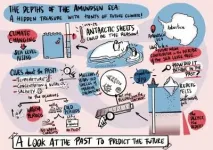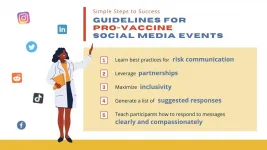A new fluorescent probe that can distinguish B cells from T cells
Unlike traditional antibody-based fluorescent staining methods, the new dye directly binds to the cell membranes of the target cells
2021-04-13
(Press-News.org) Human blood contains several different components, including plasma, red blood cells (RBCs), white blood cells (WBCs), and platelets. Among these, WBCs are divided into numerous subcategories each with unique functions and characteristics, such as lymphocytes, monocytes, neutrophils, and others. Lymphocytes are further subdivided into T lymphocytes, B lymphocytes, and NK cells. Distinguishing and separating different types of these cells is highly important in carrying out studies in the field of immunology.
Discriminating different immune cell types is typically done by flow cytometry and fluorescence-activated cell sorting (FACS), which can identify distinct populations of cells according to their size, granularity, and fluorescence. While size and granularity alone cannot distinguish cells with similar physical parameters, different types of immune cells display a distinct combination of immune receptors on the cell surfaces. For example, the T lymphocytes and B lymphocytes express CD3 and CD19, respectively. Therefore, fluorescently identifying immune cells have relied on staining the cells using multiple antibodies against different receptors. It has been long thought that it was impossible to distinguish different immune cell types without using these antibodies.
However, novel breakthrough research performed by the scientists at the Center for Self-assembly and Complexity within the Institute for Basic Science, South Korea, may have just changed this. The researchers employed a diversity oriented fluorescence library approach (DOFLA) to screen over 10,000 different fluorescent molecules using the B and T lymphocytes separated from mouse spleens. From this, they managed to discover a new fluorescent probe that can discriminate B lymphocytes over T lymphocytes without the cell receptor targeting antibodies.
The researchers called the new probe CDgB, which stands for Compound of Designation green for B lymphocytes. CDgB is a lipophilic molecule that contains a fluorescent component attached to a hydrocarbon chain. As CDgB contains both a polar fluorescent group and a hydrocarbon tail, it means that the free unbound CDgB dye molecules form aggregates similar to micelles in the solution and exhibit a low level of background fluorescence. When they attach to the cell surfaces, however, the aggregates dissociate and cause a spike in fluorescence signals. In addition, the lipophilic nature of the dye means that the dye does not bind to a protein target, and instead localizes to the lipid membrane structure directly. According to the researchers, this was "the first example to report such type of cell distinction mechanism."
The CDgB is able to selectively target the cell membranes of B lymphocytes over T lymphocytes or NK cells. The researchers sought to optimize the selectivity of the CDgB by testing different derivatives of the molecules with various hydrocarbon chain lengths from 4 to 20 carbons. It was found that the CDgB derivatives with 14 to 18 carbons showed the highest selectivity towards the B lymphocytes, with C18 showing the best results. It became more difficult to distinguish the cells through fluorescence when the carbon length was increased beyond 20. The fact that carbon length matters in the selectivity hinted that the mechanism was dependent on the difference in the membrane structures between B and T lymphocytes.
The researchers further elucidated this mechanism by performing lipidomic analysis of B and T cell membranes. Phosphatidylcholine (PC) comprises the majority (> 60%) of the membrane phospholipids of both B and T lymphocytes. It was found that B lymphocytes in general had shorter PC's than that of the T lymphocytes. In addition, the membrane cholesterol content in the T lymphocytes was about twice higher than that of B lymphocytes. These factors give the B lymphocytes a more 'flexible' cell membrane, which was thought to be a crucial factor that explains why the CDgB molecules attach more readily to the cell membranes of the B lymphocytes over those of the T lymphocytes. Even among the B lymphocytes, it was found that the strength of the fluorescence was different based on the cell maturity. The B cell progenitors and immature B cells gave off much brighter fluorescence signals than mature B cells, which is most likely due to the higher membrane flexibility in the immature cells.
The researchers furthermore concluded that this new lipid oriented live cell distinction (LOLD) mechanism can supplement the existing cell distinction mechanism to improve our ability to distinguish specific cell types from complicated mixtures of different cells. This research was published in the Journal of the American Chemical Society.
INFORMATION:
[Attachments] See images for this press release:

ELSE PRESS RELEASES FROM THIS DATE:
2021-04-13
CHAMPAIGN, Ill. -- In a state with greater income inequality, the happiest place to occupy is not at the pinnacle of the income distribution, as one might think, but somewhere in the middle that provides clear vantage points of people like ourselves, a new study suggests.
According to sociologist Tim Liao of the University of Illinois Urbana-Champaign, it's the ability to compare ourselves with people of similar backgrounds, both people who earn more and others who earn less, that determine how our income affects our happiness - not the absolute amount we earn.
"Contrary to popular belief, more income does not necessarily make people happier. The actual amount a person earns doesn't matter much in terms of happiness," Liao said. "People who can make both upward and ...
2021-04-13
New study with 756 1st through 5th graders demonstrates that a six-week mashup of hoops and math has a positive effect on their desire to learn more, provides them with an experience of increased self-determination and grows math confidence among youth. The Basketball Mathematics study was conducted at five Danish primary and elementary schools by researchers from the University of Copenhagen's Department of Nutrition, Exercise and Sports.
Over the past decades, there has been a considerable amount of attention paid to explore different approaches to stimulate children's learning. Especially, there has been a focus on how physical activity, separated from the learning activities, can improve children's cognitive performance ...
2021-04-13
Asthma afflicts more than 300 million people worldwide. The most severe manifestation, known as non-Th2, or non-atopic childhood asthma, represents the majority of the cases, greater than 85%, particularly in low-income countries, according to Hyunok Choi (https://health.lehigh.edu/faculty/choi-hyunok), an associate professor at the Lehigh University College of Health (https://health.lehigh.edu/). Yet, whether non-Th2 is a distinct disease (or endotype) or simply a unique set of symptoms (or phenotype) remains unknown.
"Non-Th2 asthma is associated with very poor prognosis in children and great, life-long suffering due to the absence of effective therapies," says Choi. "There is an urgent need to better understand its mechanistic origin to enable early diagnosis and to stop the progression ...
2021-04-13
WASHINGTON, April 13, 2021 -- From Los Angeles and the Lower East Side of New York City to Paris and Penang, street art by famous and not-so-famous artists adorns highways, roads and alleys. In addition to creating social statements, works of beauty and tourist attractions, street art sometimes attracts vandals who add their unwanted graffiti, which is hard to remove without destroying the underlying painting. Now, researchers report novel, environmentally friendly techniques that quickly and safely remove over-paintings on street art.
The researchers will present their results today at the spring meeting of the American Chemical Society (ACS). ACS Spring 2021 is being held online April 5-30. Live sessions will be hosted April 5-16, and on-demand and networking ...
2021-04-13
WHAT:
A large study of children has uncovered evidence that behavioral problems in children who snore may be associated with changes in the structure of their brain's frontal lobe. The findings support early evaluation of children with habitual snoring (snoring three or more nights a week). The research, published in Nature Communications, was supported by the National Institute on Drug Abuse (NIDA) and nine other Institutes, Centers, and Offices of the National Institutes of Health.
Large, population-based studies have established a clear link between snoring and behavioral problems, such as inattention or hyperactivity, but the exact nature ...
2021-04-13
Ammonoids, ancestors of today's octopus, squid and cuttlefish, bobbed and jetted their way through the oceans for around 340 million years beginning long before the age of the dinosaurs. If you look at the fossil shells of ammonoids over the course of that 340 million years, you'll notice something striking--as time goes on, the wavy lines inside the shell become more and more complex, eventually becoming frilled almost like the edges of kale leaves.
Fossil of Menuites oralensis with external shell removed to reveal intricate suture patterns.
These ...
2021-04-13
Children who regularly snore have structural changes in their brain that may account for the behavioral problems associated with the condition including lack of focus, hyperactivity, and learning difficulties at school. That is the finding of a new study conducted by researchers at the University of Maryland School of Medicine (UMSOM), which was published today in the journal Nature Communications.
The research was supported by the National Institute on Drug Abuse (NIDA) and nine other Institutes, Centers, and Offices of the National Institutes of Health.
To conduct study, the researchers examined MRI images collected from more than 10,000 children aged 9 to 10 years enrolled in the Adolescent Brain Cognitive Development ...
2021-04-13
Past Global Changes Horizons is a scientific review of why the study of Earth's history is important, and uses comics, pictures, and drawings that support short papers with strong messages about past sciences and how to prepare for a changing future. Articles cover different environments across the planet, from caves to oceans, and from Antarctica to the Rift valley in Africa.
Each of the 18 contributions addresses a scientific question and includes appealing and understandable figures or images, without sacrificing scientific rigor. Tips and suggestions for further research and discussion topics are also included, meaning Horizons is ...
2021-04-13
Growing more legumes, like beans and lentils, is potentially a more sustainable and nutritious approach to European agriculture, shows a new study in END ...
2021-04-13
PITTSBURGH, April 13, 2021 - What can vaccine proponents, clinicians and public health communicators learn from "anti-vaxxers?" A lot, according to new guidance for pro-vaccination social media events written by University of Pittsburgh health scientists.
The five-part guidelines, published today in the journal Vaccine, arose from an analysis of a grassroots pro-vaccination campaign organized last year by popular physician and social media personality Zubin Damania, M.D., colloquially known as "ZDoggMD." Unexpectedly, more than three-quarters of the tweets associated with the ...
LAST 30 PRESS RELEASES:
[Press-News.org] A new fluorescent probe that can distinguish B cells from T cells
Unlike traditional antibody-based fluorescent staining methods, the new dye directly binds to the cell membranes of the target cells





